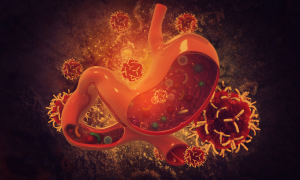Inflammatory bowel diseases and exercise

19/01/2021
Prof. dr hab. med. Jan Bilski
Introduction
The term inflammatory bowel disease (IBD) describes a group of chronic disorders that include Crohn’s disease (CD) and ulcerative colitis (UC). The incidence and prevalence of IBD, especially CD, have increased significantly over the past 50 years in countries that have adopted a “westernised” lifestyle, characterised by altered eating habits and reduced physical activity [1]. Despite the progress made in recent years, inflammatory bowel diseases’ aetiology is still not well understood. However, it is now believed that a combination of environmental factors, alterations in the gut microbiota, and a dysfunctional mucosal immune system in genetically susceptible individuals can lead to CD or UC [2]. It seems that alterations in the composition and diversity of the intestinal microbiota, e.g. caused by a diet change, could be critical in IBD development [3]. Patients with IBD were previously considered malnourished, and overweight was relatively rare; however, recent studies have shown an increasing incidence of obesity in these patients, and it has been suggested that this could have a negative impact on the course of the disease [4].
Patients usually present with abdominal pain, bloating, liquid and bloody diarrhoea, and systemic symptoms such as anorexia, malaise, fatigue, weight loss, fever and various extra-intestinal symptoms. CD is also characterised by marked alterations in mesenteric adipose tissue properties, and a recent study has demonstrated that the mechanism of these changes is a mechanism dependent on the intestinal microbiota [5].
Physical activity in IBD patients
Epidemiological studies have associated physical activity in the pre-illness period with a reduced risk of developing inflammatory bowel disease, and this association was stronger for CD [6]. Moderate physical activity has been suggested as a potentially beneficial adjunctive therapy for IBD patients with less active disease [6]. The beneficial effects of regular exercise in chronic diseases may arise not only from the long-term effect on abdominal obesity but also from the anti-inflammatory environment created by the myokines released from active skeletal muscles during exercise [7]. Despite recommendations promoting the benefits of exercise for IBD patients, several studies have shown that physical activity in these patients is generally significantly lower than in healthy subjects. This reluctance to exercise may be due to easy fatigue, reduced muscle strength, a sense of discomfort resulting from frequent use of the bathroom, and fear of worsening the disease’s symptoms. However, in these patients, exercise may counteract some complications, improving mental health, bone mineral density, muscle mass, strength, and overall nutritional status, and reducing fatigue. In CD myokines may counteract the pro-inflammatory adipokines released by pathologically modified mesenteric fat, thus contributing to the skeletal muscle and adipose tissue crosstalk [8,9]. The discovery that skeletal muscle acts as a secretory organ producing cytokines and other muscle-derived peptides and their ability to modify adipose tissue metabolism constitutes a breakthrough in our understanding of muscle-fat crosstalk [10].
However, prolonged and strenuous exercise may have a pro-inflammatory effect and increase pro-inflammatory cytokines in tissues and plasma. Athletes who engage in gruelling sports such as marathons and triathlons may suffer from “runner’s ischemic colitis”, which includes bloody diarrhoea, fatigue and fever, and prevalence of these symptoms is very high [11,12].
What can we learn from animal experiments?
The experimental animal studies allow to compare exercises of different design and intensity and provide a better insight into the potential mechanisms through which exercise could exert its effects. Experimental colitis models have been reported to be suitable for studying the effects of exercise on colitis and understanding the protective and anti-inflammatory mechanisms of physical activity. We set out to test the hypothesis that the extent and severity of experimental colitis worsened in high-fat diet (HFD)-fed mice and that the beneficial effects of exercise could be obtained by modifying the muscle-fat crosstalk [13,14].
We have shown that healing in experimental colitis was impaired in HFD-fed mice. This effect was accompanied by decreased colonic microcirculation and plasma adiponectin concentration and increased pro-inflammatory biomarkers in mesenteric fat, indicating that pathological alterations in mesenteric adipose tissue can be critical in the development of experimental colitis. Voluntary physical activity (running wheel) improved experimental colitis by reducing the severity of colon damage, possibly increasing colonic blood flow and releasing protective myokines, such as irisin, from skeletal muscle. These beneficial effects of physical activity were especially pronounced in HFD-fed mice [14]. On the other hand, forced treadmill running exacerbated the severity of colonic damage in mice, possibly due to a reduction in colonic microcirculation and the rise in pro-inflammatory biomarkers’ expression and activity [13].
Conclusions
Light to moderate exercise appears to be safe and may benefit IBD patients to prevent relapse, maintain nutritional status, and improve quality of life. However, our research confirms and further extends previous observations that prolonged and vigorous exercise can exacerbate inflammatory responses.
References
1. Molodecky N.A.; Soon, I.S.; Rabi, D.M.; Ghali, W.A.; Ferris, M.; Chernoff, G.; Benchimol, E.I.; Panaccione, R.; Ghosh, S.; Barkema, H.W., et al. Increasing incidence and prevalence of the inflammatory bowel diseases with time, based on systematic review. Gastroenterology 2012, 142, 46-54 e42; quiz e30, doi:10.1053/j.gastro.2011.10.001.
2. Torres, J.; Mehandru, S.; Colombel, J.F.; Peyrin-Biroulet, L. Crohn’s disease. Lancet 2017, 389, 1741-1755, doi:10.1016/S0140-6736(16)31711-1.
3. Schaubeck, M.; Haller, D. Reciprocal interaction of diet and microbiome in inflammatory bowel diseases. Curr Opin Gastroenterol 2015, 31, 464-470, doi:10.1097/MOG.0000000000000216.
4. Bilski, J.; Mazur-Bialy, A.; Wojcik, D.; Surmiak, M.; Magierowski, M.; Sliwowski, Z.; Pajdo, R.; Kwiecien, S.; Danielak, A.; Ptak-Belowska, A., et al. Role of Obesity, Mesenteric Adipose Tissue, and Adipokines in Inflammatory Bowel Diseases. Biomolecules 2019, 9, 780, doi:10.3390/biom9120780.
5. Ha, C.W.Y.; Martin, A.; Sepich-Poore, G.D.; Shi, B.; Wang, Y.; Gouin, K.; Humphrey, G.; Sanders, K.; Ratnayake, Y.; Chan, K.S.L., et al. Translocation of Viable Gut Microbiota to Mesenteric Adipose Drives Formation of Creeping Fat in Humans. Cell 2020, 183, 666-683.e617, doi:10.1016/j.cell.2020.09.009.
6. Bilski, J.; Wojcik, D.; Danielak, A.; Mazur-Bialy, A.; Magierowski, M.; Tonnesen, K.; Brzozowski, B.; Surmiak, M.; Magierowska, K.; Pajdo, R., et al. Alternative Therapy in the Prevention of Experimental and Clinical Inflammatory Bowel Disease. Impact of Regular Physical Activity, Intestinal Alkaline Phosphatase and Herbal Products. Curr Pharm Des 2020, 26, 2936-2950, doi:10.2174/1381612826666200427090127.
7. Pedersen, B.K.; Saltin, B. Exercise as medicine – evidence for prescribing exercise as therapy in 26 different chronic diseases. Scand J Med Sci Sports 2015, 25 Suppl 3, 1-72, doi:10.1111/sms.12581.
8. Mazur-Bialy, A.; Bilski, J.; Pochec, E.; Brzozowski, T. New insight into the direct anti-inflammatory activity of a myokine irisin against proinflammatory activation of adipocytes. Implication for exercise in obesity. Journal of Physiology and Pharmacology 2017, 10.
9. Bilski, J.; Mazur-Bialy, A.; Brzozowski, B.; Magierowski, M.; Zahradnik-Bilska, J.; Wojcik, D.; Magierowska, K.; Kwiecien, S.; Mach, T.; Brzozowski, T. Can exercise affect the course of inflammatory bowel disease? Experimental and clinical evidence. Pharmacol Rep 2016, 68, 827-836, doi:10.1016/j.pharep.2016.04.009.
10. Severinsen, M.C.K.; Pedersen, B.K. Muscle-Organ Crosstalk: The Emerging Roles of Myokines. Endocr Rev 2020, 41, bnaa016, doi:10.1210/endrev/bnaa016.
11. Bilski, J.; Mazur-Bialy, A.; Magierowski, M.; Kwiecien, S.; Wojcik, D.; Ptak-Belowska, A.; Surmiak, M.; Targosz, A.; Magierowska, K.; Brzozowski, T. Exploiting Significance of Physical Exercise in Prevention of Gastrointestinal Disorders. Curr Pharm Des 2018, 24, 1916-1925, doi:10.2174/1381612824666180522103759.
12. Costa, R.J.S.; Snipe, R.M.J.; Kitic, C.M.; Gibson, P.R. Systematic review: exercise-induced gastrointestinal syndrome-implications for health and intestinal disease. Aliment Pharmacol Ther 2017, 46, 246-265, doi:10.1111/apt.14157.
13. Bilski, J.; Mazur-Bialy, A.; Wojcik, D.; Magierowski, M.; Surmiak, M.; Kwiecien, S.; Magierowska, K.; Hubalewska-Mazgaj, M.; Sliwowski, Z.; Brzozowski, T. Effect of Forced Physical Activity on the Severity of Experimental Colitis in Normal Weight and Obese Mice. Involvement of Oxidative Stress and Proinflammatory Biomarkers. Nutrients 2019, 11, 1127, doi:10.3390/nu11051127.
14. Mazur-Bialy, A.I.; Bilski, J.; Wojcik, D.; Brzozowski, B.; Surmiak, M.; Hubalewska-Mazgaj, M.; Chmura, A.; Magierowski, M.; Magierowska, K.; Mach, T., et al. Beneficial Effect of Voluntary Exercise on Experimental Colitis in Mice Fed a High-Fat Diet: The Role of Irisin, Adiponectin and Proinflammatory Biomarkers. Nutrients 2017, 9, doi:10.3390/nu9040410.

